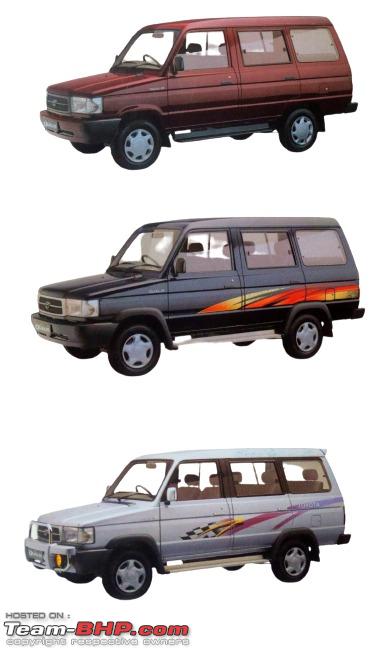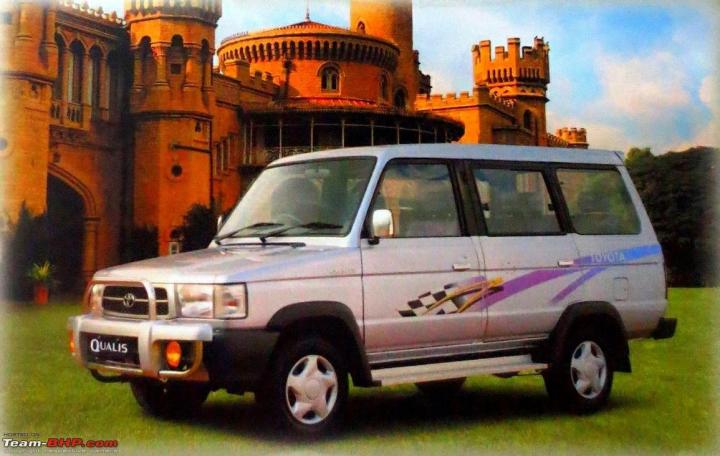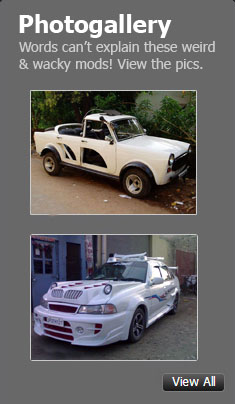News
Tribute to the Toyota Qualis: Redefining India's MUV segment
Back in the day, the Tata Sumo & Mahindra Armada were the two major players in the MUV segment in India.
BHPian Shreyfiesta recently shared this with other enthusiasts.
Toyota Qualis, an interesting model that set the foundation for the Toyota brand in India.
Established in 1997 as an 87:13 joint venture between Toyota and Kirloskar Group, Toyota Kirloskar Motor Private Limited has grown rapidly to emerge as a significant player in India’s passenger car segment. The company made an investment of about 600 crores at Bidadi near Bengaluru and targeted to sell at least 31,000 vehicles in the first year of operation. Toyota's manufacturing plant had a capacity of producing 50,000 units annually of its first model for India. Despite strong growth in the passenger car market in the late-90s, Toyota decided to enter India through the MUV segment. This decision was taken based on an extensive market study and analysis that indicated the potential for a world-class MUV that would offer the driving experience of a car, at an affordable price.
India's multi-utility vehicle segment had two major players at that time, the Tata Sumo and the Mahindra Armada. Though these models were decently reliable, people never saw them as substitutes for a car. Those were the days when most car manufacturers in India were competing hard for a share in the crowded passenger small car market. So, Toyota's decision was to introduce an MUV, with a passenger car ambience similar to Kijang in Indonesia, Venture in South Africa, Zace in Taiwan and Tomaro in the Philippines. Actually, this MUV project was kept as a highly guarded secret by Toyota. Also, it was said that Toyota will bring a passenger car after launching the MUV, but the model was not disclosed.
As per the investment pattern worked out by Toyota Kirloskar Motor, during the first phase, its investment in the vehicle project was around $170 million, in the second phase, between $400 - $700 million and for each subsequent model around $400 million. The company utilised only 18 per cent of the 430 acres of land at first, the rest was planned to be utilised once the second model and plans for the launch of a small car were fixed. The MUV being developed was an India specific model with a chassis based on the Toyota Utility Vehicle concept. It was designed like a passenger car with seating configurations of 3-3-4 and 2-3-3 sets of seats. As a part of its launch strategy, Toyota had decided to do away with the practice of bookings, so they became one of the first car brands to introduce such an international concept here. No indication of the vehicle's price was given, but had stated that it will carry an affordable price tag.
Fast forward to December 1999, Qualis, the much-awaited MUV from Toyota rolled out from its Bidadi facility for the first time. The event which was called line-out in the Toyota parlance marked in the commercial production of the vehicle. For auto enthusiasts, it appeared that Toyota was trying to position the Qualis as a car rather than a multi-utility vehicle. Toyota's idea was to benchmark itself in the Indian market against sedans like Mitsubishi Lancer and Honda City rather than a Tata Sumo or a Safari. The pricing of Qualis was still kept as a closely guarded secret with not even the trade knowing exactly how much the MUV will cost. It was assumed by the industry sources that the price of Qualis will be around ₹ 6 lakh for the basic variant.
Finally, the wait for Qualis was about to end. Toyota themselves announced that its first model in India will be unveiled at the Auto Expo in January 2000. Delivery was planned to be done on a first-come-first-serve basis and the company intended to collect only a token amount from the customers at the time of booking. In case if demand exceeds supply, Toyota's plan was to put prospective customers on a waiting list. By then, Toyota had gained a dealership network of 25 dealers in 22 major cities. All these dealers had an integrated sales, aftersales and spare parts storage facility. For starters, around 40 vehicles were dispatched to each of these dealers, to be sold on a first-come-first-serve basis. Around 350 units of Qualis were manufactured by December 1999 and were dispatched to various dealers across the country.
11th January 2000
Toyota finally made a scorching entry into the Indian auto market with a bargain that many found hard to resist. It was offering the base variant of the Qualis, an 8-10 seater MUV, for an invitation price of ₹ 4.6 lakhs ex-showroom. This was virtually on a par with Tata Sumo and a lot cheaper than the other cars in the mid-size segment. Actually, this was just an introductory offer, they were selling it below production cost. The initial plan was to increase the prices after Toyota establishes itself in the market. These price tags were an extension of the touch-and-try campaign for the fact to be said.
Variants launched were
- Family Saloon without A/C, priced at ₹ 4.59 lakhs ex-showroom
- Family Saloon with A/C, priced at ₹ 4.99 lakhs ex-showroom
- Family Saloon with A/C and PS, priced at ₹ 5.32 lakhs ex-showroom
- Grand Saloon with A/C and PS, priced at ₹ 5.77 lakhs ex-showroom
- Grand Saloon with double A/C, PS, PW and 2 speakers, priced at ₹ 6.6 1lakhs ex-showroom
- Grand Saloon Touring, priced at ₹ 7.40 lakhs ex-showroom
Toyota had studied the Indian car market very well before entering. The company worked for developing the best-suitable car that would match the special requirements of India's car market. Toyota focused on developing a car that would cater to the unique needs of Indian buyers. It was evident that they had given serious consideration to the special needs of the Indian consumers. Also, they were committed to ensuring that the Qualis was designed, engineered and built with the Indian consumer in mind. Unlike many other manufacturers, Toyota wanted customers to try its product at an attractive price. The 'Touch & Try' campaign was able to woo a large number of customers. The marketing strategy was backed by a strong product, was economically priced, safe and comfortable. The Qualis was always marketed as a family car, and not just as a utilitarian multi-purpose vehicle.



Everything about the Qualis
Exterior
The Qualis, in all probability, is one of the worst looking automobiles ever sold in India. But like bread boxes are good at holding bread, the Qualis was good at carrying people and surely, the finish was better than other UVs sold in our country back then. Build quality was superbly executed with uniform panel gaps which put some mid-sized cars to shame. The shabby body panel just below the door lines was glaringly visible with all the ungainly weld spots. Anyways, we all had castigated the Qualis for its unappealing design at that time.
From all sides, the Qualis looked too boxy due to its tiny 14-inch wheels, van-like tailgate, and wraparound indicators. Even in the 2000s, it had an outdated MUV image to show.

On a vehicle like the Qualis, exposed weld spots and panel joints were not so good. For the truth to be told, most people got used to the design of Qualis over the years and, I even thought of buying one every time when a group of guests arrived with their scary assortment of baggage. Toyota had a better-looking version around for the eastern markets which can compare well with the Tavera and Scorpio when it comes to exterior design. Let us not waste time here, the Qualis doesn't have anything exciting on the design side.
The design of the Qualis was purely functional, intended only to transport people from point A to point B.

Interior
The same attention to detail was carried over to the interior too, everything felt good to touch and were clearly laid out, especially when compared to the other utility vehicles from that era. Qualis had ample headroom and adequate legroom too. Seats were designed very excellently for the fact to be said, grades of fabric were different in each variant. A major disappointment was the lack of legroom for the front seats, which meant tall passengers had to sit with their legs splayed. The company had ensured that the Qualis was produced like any other Toyota and that meant good fit, finish and overall build quality.
Inside, the layout and trim was well-presented and effectively executed. No rich-looking textures were present on the dashboard, but everything felt hard-wearing and reliable.

In the 10-seater layout, second and third rows of seats offered various configurations to manage the different needs of users. At the front, these models had a separate seat for the driver and a flat 2-seater bench for side passengers. There existed two 2-seater benches at the rear placed along the sidewalls of the vehicle, both benches were foldable and detachable. The easy-folding rear seats enabled users to configure the seat arrangements for easy entry, exit and multipurpose usage.
Various seating arrangements possible inside the cabin of a Qualis shown in a 2001 brochure.

All seats were front-facing in the 8-seater layout models (GST and optional in GS). Independent seats were provided at the front for both driver and side passenger. The middle row seats were able to accommodate three passengers and the third row also had a 3-person bench. Like what I said about the 10-seater layout models, these 8-seater layout models also had foldable and detachable rear rows. When both rows are removed, the Qualis can even carry a motorcycle very comfortably inside its cabin. The boot lid opened upward and offered a great loading platform to make things easier.
An RD350 sitting comfortably inside a Qualis after removing second and third rows of seats. This particular car was a 2001 FS 10-seater.

The options of both single and dual air-conditioning were designed specifically for India's extreme weather conditions. Frankly speaking, the entire air-con unit of Qualis was top-class in those days. GST being the most expensive variant, had a roof-mounted blower unit at the middle row and a wooden-finished centre console. The same GST variant was available without the twin blower air-con setup also, it was possible for customers to delete these standard types of equipment IIRC. Toyota sensed the need for child-proof locks and wind-down rear door windows and began to offer those features from 2002 onwards. The pre-facelift model had sliding door windows in the second row.
Ride & Handling
Qualis had a robust and proven ladder-type frame with a twin wishbone and torsion bar set-up in front and leaf spring suspension at the rear. The front suspension worked well and the small 14-inch wheels made the Qualis very nimble. Brakes were terrific, had the right amount of feel and never unsettled the vehicle when applied hard. The suspension was on the softer side and hence the Qualis rode best at low speeds and on paved roads. The tiny 175 R14 tyres provided decent grip but a larger footprint, especially under a full load, would have been better. Ground clearance, despite those stunted 14-inch wheels, was adequate, and this meant that the Qualis used to tackle bad roads with ease. Yes, city and intercity trips were equally comfortable to its passengers.
Look at the stingy 14-inch wheels, the Qualis always craved for bigger wheels. Picture from BS Motoring's April 2002 issue.

The rev-sensing power steering system made the work of turning this big vehicle around easier. With 3.5 turns lock to lock and a turning circle of just 9.8 metres, the Qualis is still a highly manoeuvrable tool in the bumper to bumper rush hour traffic. The steering system always took away all the feedback from the driver's hands and led to a sense of overconfidence around fast corners most of the time. The tall gear lever with long throws, the two-spoke steering wheel, the hand brake lever's position and other controls were actually easy to handle for the driver. The driving position was superb, and this is one of the very few vehicles that is suitable for a person who's not driven anything bigger than a Maruti 800 or a Tata Nano.
The light and nimble Qualis is almost like a car to drive. Suspension is on the softer side. Picture from BS Motoring's April 2002 issue.

Engine & Transmission
Under the hood of the Qualis lied a 2.4-litre four-cylinder 8V variant of Toyota's 2L engine. The same unit was seen in myriad Toyota saloons, pick-up trucks and vans worldwide. This diesel engine sported an all-square bore and stroke configuration - 92x92mm. Using distribution type fuel injection and operating on a 22.1:1 compression ratio, the engine delivered an adequate 74bhp at 4200rpm and 151Nm of torque at 2400rpm. Mated with the unit was a G-58 five-speed manual transmission. Even in the diesel-engined guise, the Qualis was supremely refined.
Qualis's 2.4-litre 2L unit was smoother and more refined than that of the Tata Safari's 1.9-litre 90bhp unit. Picture from Autocar India's August 2002 issue.

These diesel-powered vehicles were capable to clock the zero to 60kmph sprint in 8.7 seconds while zero to 100kmph came up in an agonising 26.3 seconds. In the early-2000s, the holder of the 'fastest MUV' label in India was the Tata Sumo Turbo which did a top speed of 136kmph while the Qualis GS diesel had maxed out at 132kmph. The unit felt eager and willing with an ample torque spread in the real world. The engine’s responsive nature and super-slick gearshift helped in making the Qualis like a car. Where the Qualis lost out was in top-end performance. Beyond 100kph, progress was slow and the engine liked not to be revved harder. So was this a totally capable car or a simple people-mover, like it was designed to be in the eighties? Toyota always wanted Indians to believe that the Qualis was targeted against mid-sized sedans.
Performance figures from the Scorpio SZ2600 vs Safari vs Qualis vs Sumo Turbo vs Bolero XD3P comparison test conducted by Autocar India in 2002.

A petrol-powered version of the Qualis was released later in January 2002 with Toyota's 1 RZ-E four-cylinder, single overhead cam engine. The unit was capable to belt out 92bhp at 4800rpm, while also capable of churning up the rear wheels with a reasonably torquey 150Nm at a surprisingly calm 2800rpm. The move to a petrol engine was pretty much expected, thanks to the imminent dismantling of the administered price mechanism for petrol and diesel which the government had assured to manifest itself from mid-2002. While Mahindra had plans for an Isuzu-engined Armada and MM550 earlier, nothing much materialised.
An unfamiliar petrol engine under the familiar hood. Though the motor was torquier than that of City and Lancer, the same was not reflected in the acceleration figures. Picture from BS Motoring's December 2001 issue.

Initial acceleration tests between 0-60kmph and 0-100kmph pulled out 6.6 seconds and 18.8 seconds respectively, and though not anywhere close to petrol sedan figures, that was ample performance from a big boxy vehicle like the Qualis. A top speed of 142kmph was the most respectable figure for a vehicle of its class in those days. The same gearbox from diesel was retained, including the internal ratios but the final drive was changed to a 4.555:1 ratio in place of the 4.100:1 on the diesel-engined versions.
Acceleration test conducted for the Qualis GST petrol recorded a 0-100kmph figure in 18.86 seconds. Data from Overdrive India December 2001.

Continue reading about the updates, facelifts, and special editions of the Qualis for BHPian comments. insights and information.
- Tags:
- Indian
- Member Content
- Toyota
- Qualis








.jpg)









